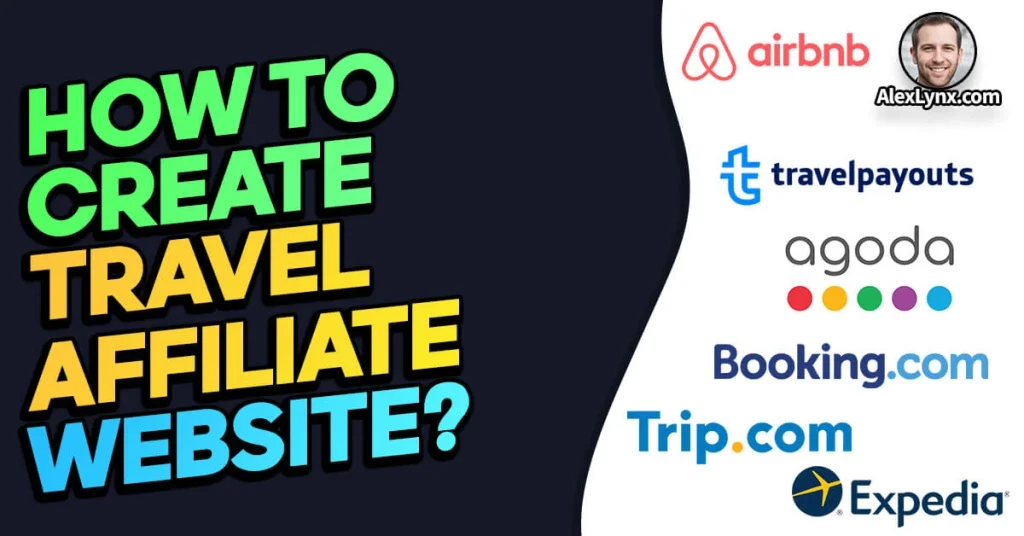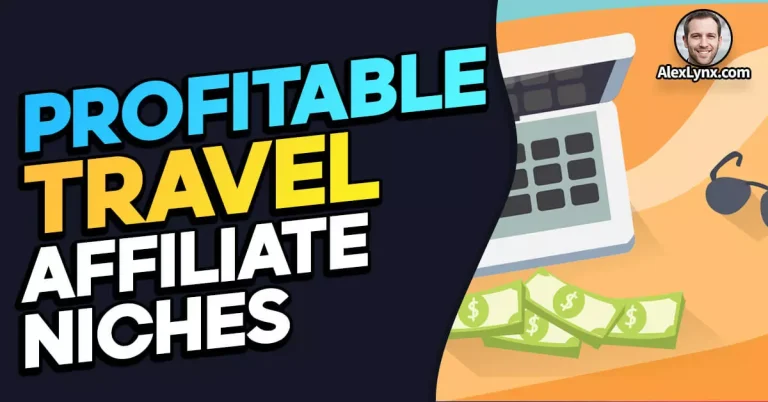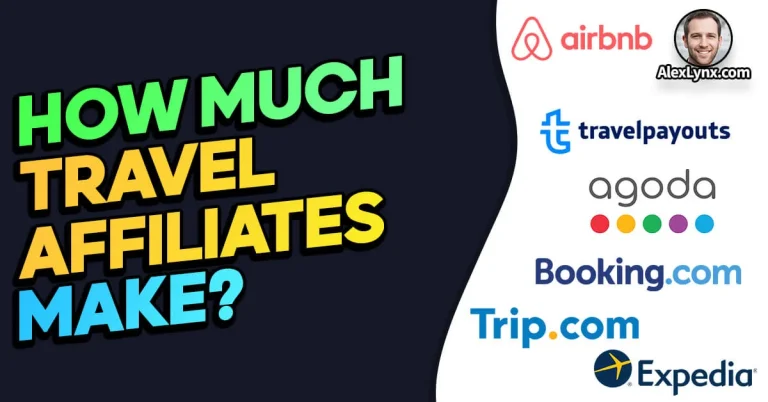Welcome, Wanderlust Web-preneurs!
So, you’ve caught the travel bug, and you want to share your passion with the world while making a pretty penny. Well, you’re in the right place! In this step-by-step guide, we’ll show you how to create a travel affiliate website that’s not just a pretty face but also a cash-generating machine. Let’s dive in!
1. How to Create a Successful Travel Affiliate Website

Unlocking the Potential of Travel Affiliate Websites
First things first, let’s talk about the massive potential of travel affiliate websites. Imagine earning a commission every time one of your readers books a hotel, flight, or tour through your website. Sounds like a dream, right? Well, buckle up, because we’re here to turn that dream into reality. With the right strategies, your travel affiliate website can become a steady source of income while you share your love for exploring the world.
A Well-Structured, User-Friendly Site
Before we embark on this exciting journey, it’s crucial to understand the importance of creating a well-structured, user-friendly site. Think of your website as a virtual storefront—your visitors should be able to navigate it easily, find the information they’re looking for, and be enticed to click on those affiliate links. An organized and visually appealing website will not only keep your readers engaged but also boost your search engine rankings. So, let’s make sure your site is dressed to impress!
Your Roadmap to a Profitable Travel Affiliate Website
We’ve got quite the adventure ahead of us, so let’s lay out the itinerary. In this comprehensive guide, we’ll cover everything from choosing your niche and setting up your domain and hosting, to customizing your website design, creating valuable content, and promoting your brand-new travel affiliate website. We’ll also throw in some handy tips, examples, and analogies along the way to make your journey as smooth as possible. So, grab your metaphorical backpack, and let’s learn how to create a travel affiliate website that will have you jet-setting to success in no time!
Stay tuned for the next sections where we’ll dive deep into choosing your niche, setting up your domain and hosting, and more. Don’t forget to bookmark this page so you can easily find your way back to continue your journey towards a thriving travel affiliate website. Safe travels, and happy earnings!
2. Choosing Your Niche
Embarking on the journey to create a travel affiliate website without a niche is like setting off on a road trip without a map. You need a direction, a purpose, and a specific audience in mind. So, let’s dive into the importance of choosing your niche, researching your competition, and identifying those oh-so-profitable sub-niches.
The Importance of a Specific Audience
When it comes to travel, one size does not fit all. That’s why targeting a specific audience is crucial for your travel affiliate website. By focusing on a niche, you’ll not only create a more relevant and appealing site but also boost your chances of turning curious clicks into sweet commissions. It’s like creating a cozy travel cafe tailored to your customers’ tastes, rather than a generic, overwhelming buffet.
Researching and Analyzing Your Competition
Before you hit the road to niche discovery, it’s time for some good old-fashioned sleuthing. Start by researching and analyzing your competition. Check out other travel affiliate websites catering to a similar audience, and observe what they’re doing well and where they might be missing the mark. Are they covering every corner of luxury travel, or have they overlooked a unique boutique hotel experience? Use this information to your advantage and create a travel affiliate website that fills in the gaps and steals the show.
Identifying Profitable Sub-Niches
Now that you’ve scoped out the landscape, it’s time to dig deeper and uncover those profitable sub-niches within your chosen niche. For instance, if you’re focusing on adventure travel, consider creating content about off-the-beaten-path destinations, adrenaline-pumping activities, or essential gear for thrill-seekers. This will not only make your website more engaging and informative but also increase the likelihood of your readers clicking on those enticing affiliate links.
So, strap on your thinking helmet, conduct some research, and carve out a unique space in the travel market. By selecting the ideal niche for your travel affiliate website, you’ll be one step closer to reaping the rewards and making your mark in the travel industry. Remember, the more specific and targeted your niche, the better your chances of turning your wanderlust into a profitable venture. Happy niche hunting!
3. Domain and Hosting
Welcome, brave adventurer, to the exciting world of travel affiliate website creation! Today, we’ll embark on a quest to establish your digital domain and fortify your hosting. So grab your virtual passport, and let’s get going!
Choosing the Right Domain Name

First things first, intrepid entrepreneur: you need a domain name. This name will be the address of your digital home, where travelers can find your treasure trove of travel wisdom. Here are some tips for choosing a name that’s memorable and meaningful:
- Keep it relevant: Make sure your domain name hints at the content of your website. If you’re creating a travel affiliate website, something like “WanderingWidgets.com” might not give visitors the right idea.
- Short and sweet: Aim for a name that’s easy to remember, spell, and type. Something like “TheIncredibleJourneyOfATravelAficionado.com” might be a bit too much.
- Be unique: You want a name that stands out in the crowd. If there are already several websites with similar names, it’s best to choose a different direction.
Selecting a Reliable Hosting Provider

Now that you’ve chosen a name for your travel affiliate website, you’ll need a reliable hosting provider to keep it online. Just like a sturdy backpack and a comfortable pair of shoes are essential for any journey, a good hosting provider is essential for your website’s success. Consider the following when selecting your digital travel companion:
- Uptime: Look for a hosting provider that guarantees at least 99.9% uptime. You don’t want your website to be down when your audience is ready to explore!
- Customer support: Choose a provider with helpful and responsive customer support. You never know when you might need a helping hand on your digital journey.
- Scalability: As your travel affiliate website grows, you’ll need a hosting provider that can grow with you. Make sure your provider offers options for increasing resources as your traffic increases.
Beginner-friendly 🏆
Bluehost is a very well-rounded hosting provider, offers a blend of superlative support, security, and reliability at an easy-to-stomach price point. Great security: Bluehost has some of the best website security measures on the market to give you peace of mind.
Best choice

A2Hosting ranks on our list of the best web hosting providers of 2023. It’s fast and offers both excellent customer service and competitive pricing on long-term plans. A2hosting Shared plan includes a free SSL as well. Read our full A2 Hosting review for a closer look.
Great option
SiteGround is one of the best web hosting services because of its high uptime guarantee of 99.99% and great speed of 311ms. All of its shared hosting plans include free SSL certificates, email accounts, native CDN, automatic backups, and built-in caching.
Linking Your Domain and Hosting
With your domain name and hosting provider in hand, it’s time to unite these two elements and launch your travel affiliate website. Here’s a simple step-by-step guide to connecting your domain and hosting:
- Access your domain registrar: Log in to the account where you purchased your domain name.
- Update nameservers: Find the section for updating nameservers or DNS settings. Replace the default nameservers with the ones provided by your hosting provider.
- Confirm the connection: Once you’ve updated the nameservers, it can take anywhere from a few minutes to 48 hours for the changes to propagate. Keep an eye on your website’s address to see when it goes live.
- Celebrate: Congratulations, traveler! Your digital home is now ready for visitors. Time to pop the virtual champagne and celebrate your success in creating a travel affiliate website.
And there you have it! With your domain name chosen, hosting provider selected, and the two connected, you’re well on your way to travel affiliate stardom. Happy journeying, and may your website thrive in the vast digital landscape!
4. Selecting the Perfect Website Platform
Now that you’ve honed in on your niche, it’s time to set up shop! But with so many website platforms out there, how do you choose the one that’s right for your travel affiliate website? Fear not, intrepid explorer! We’re here to help you navigate the world of website builders and find the perfect platform for your needs.
WordPress, Wix, and Squarespace
Picture this: you’re on a tropical island, and you have to choose between three different boats to sail home. Each boat has its own set of features, and it’s up to you to decide which one best suits your needs. In the world of website platforms, WordPress, Wix, and Squarespace are the top contenders vying for your attention. Let’s take a closer look at each:
- WordPress: The trusty, customizable workhorse. With its vast array of themes and plugins, WordPress is the go-to choice for many travel affiliate websites. It offers the flexibility and control you need to make your site uniquely yours. However, this platform can be a bit more challenging for beginners.
- Wix: The user-friendly, drag-and-drop dreamboat. Wix is perfect for those who want a visually appealing website without diving deep into the world of coding. It’s easy to use and offers a variety of templates, but it may lack some of the advanced features and customization options found in WordPress.
- Squarespace: The stylish, all-in-one luxury yacht. Squarespace is known for its sleek, professional-looking designs and user-friendly interface. It’s a great option if you want a polished website with minimal fuss. However, its limited selection of themes and plugins may leave you wanting more.
Choosing the Best Option for Your Needs
When deciding on the perfect website platform for your travel affiliate website, consider your level of expertise, the amount of customization you desire, and the specific features you’ll need. If you’re a coding newbie looking for simplicity and ease of use, Wix or Squarespace might be your best bet. However, if you’re a tech-savvy trailblazer who wants full control over your site’s appearance and functionality, WordPress could be your platform soulmate.
Setting Up Your Website
Once you’ve chosen your platform, it’s time to set sail and build your travel affiliate website! Follow the platform-specific setup instructions to create your account, choose a template, and start customizing your site. Remember, Rome wasn’t built in a day, and neither will your website be. Be patient, take your time, and don’t be afraid to ask for help if you need it.
In the end, selecting the right website platform is crucial for creating a travel affiliate website that’s not only visually appealing but also functional and user-friendly. So, weigh your options, choose wisely, and embark on the exciting journey of building your dream travel website!
5. Customizing Your Website Design
Now that you’ve chosen your platform, it’s time to roll up your sleeves and get creative! In this part of our “how to create a travel affiliate website” journey, we’ll explore the importance of a visually appealing and user-friendly layout, selecting a professional travel website theme, and customizing your site’s appearance.
The Importance of a Visually Appealing and User-Friendly Layout
Your travel affiliate website is like a virtual postcard—it should showcase the beauty and allure of the destinations you cover. An eye-catching and user-friendly layout not only keeps your visitors engaged but also helps guide them to the information they seek and, ultimately, those coveted affiliate links. So, ensure your site is both a visual masterpiece and a well-organized treasure map.
Selecting a Professional Travel Website Theme
When it comes to choosing a theme for your travel affiliate website, think of it as selecting the perfect outfit for a fancy event—you want to look polished and professional, yet still express your unique personality. Browse through your chosen platform’s theme library and search for travel-specific templates that align with your niche and vision. Look for a theme that’s not only visually appealing but also responsive, SEO-friendly, and easy to navigate.
Customizing Your Website’s Appearance
With your theme in place, it’s time to unleash your inner artist and customize your website’s appearance. Add your logo, choose your color scheme, and select the perfect fonts to represent your brand. Don’t forget to include eye-catching images and captivating headlines that showcase your travel expertise.
As you customize your site, keep your target audience in mind—what would appeal to them and make their user experience exceptional? For example, if you’re targeting adventure-seekers, consider incorporating bold colors and high-quality action shots. By tailoring your design to your audience, you’ll create a travel affiliate website that feels like a home away from home for your visitors.
In conclusion, a visually stunning and user-friendly design is key to creating a travel affiliate website that captures your audience’s attention and keeps them coming back for more. By selecting the perfect theme and customizing your site’s appearance, you’ll create a digital destination that’s as memorable and inspiring as the journeys you share. Happy designing!
6. Essential Website Features and Plugins
Creating a travel affiliate website is like constructing a magnificent skyscraper—you need the right tools and features to ensure its success. In this leg of our “how to create a travel affiliate website” adventure, we’ll explore essential website features and plugins, including booking and reservation tools, SEO optimization plugins, social sharing and email marketing integrations, and analytics and reporting tools.
Booking and Reservation Tools
Your travel affiliate website should not only inspire your visitors but also make it easy for them to book their dream vacations. By integrating booking and reservation tools, you’ll provide a seamless user experience and increase the likelihood of earning commissions. Popular options include Booking.com Affiliate Partner Program, Expedia Affiliate Network, and TripAdvisor Affiliate Program. Choose the tool that best aligns with your niche and audience.
Optimization Plugins
In the world of travel affiliate websites, SEO is like oxygen—essential for survival. To ensure your site ranks high in search engine results, consider adding SEO optimization plugins like Yoast SEO (for WordPress users) or the built-in SEO features in Wix and Squarespace. These tools will help you optimize your content, enhance your website’s performance, and make it easier for travelers to discover your site.
Social Sharing and Email Marketing Integrations
Your travel tales deserve to be shared far and wide. By integrating social sharing buttons and email marketing tools into your website, you’ll make it easy for your visitors to spread the word about your content and subscribe to your newsletter. Popular options include AddThis or ShareThis for social sharing, and Mailchimp or ConvertKit for email marketing. Choose the tools that best suit your needs and watch your audience grow.
Analytics and Reporting Tools
In the wild world of travel affiliate websites, data is your compass. It helps you understand your audience, measure your success, and make informed decisions for your site’s future. Integrating analytics and reporting tools like Google Analytics, Jetpack (for WordPress), or the built-in analytics features in Wix and Squarespace will provide valuable insights into your site’s performance, visitor behavior, and traffic sources.
In conclusion, equipping your travel affiliate website with essential features and plugins will not only enhance its functionality but also help you connect with your audience, optimize your content, and track your success. By building the ultimate travel toolbox, you’ll be well on your way to creating a travel affiliate website that soars above the competition. Happy building!
7. Creating Valuable Content for Your Travel Affiliate Website
In the realm of travel affiliate websites, content is king. But how do you craft content that captivates your audience, inspires wanderlust, and drives those all-important affiliate clicks? In this installment of our “how to create a travel affiliate website” odyssey, we’ll delve into identifying and understanding your target audience, crafting engaging, informative, and share-worthy content, and balancing promotional content with valuable information.
Identifying and Understanding Your Target Audience
Creating valuable content begins with understanding who you’re creating it for. Just like a skilled chef knows their patrons’ tastes, you should be familiar with your target audience’s preferences and pain points. Ask yourself: what are their travel goals and aspirations? What kind of information are they seeking? By knowing your audience inside and out, you’ll be able to tailor your content to their needs and desires, making your travel affiliate website their go-to resource.
Crafting Engaging, Informative, and Share-Worthy Content
Your travel affiliate website should be a treasure trove of engaging, informative, and share-worthy content that keeps your audience coming back for more. To create content that hits the mark, consider the following:
- Storytelling: Weave captivating narratives that transport your readers to far-off lands and ignite their imaginations.
- Practicality: Offer practical tips, advice, and resources that help your audience plan and navigate their own adventures.
- Visuals: Enhance your stories with eye-catching images and videos that bring your travel tales to life.
By combining these elements, you’ll create content that resonates with your audience, encourages social sharing, and sets your travel affiliate website apart from the competition.
Balancing Promotional Content with Valuable Information
As a travel affiliate website owner, you need to strike a delicate balance between promoting affiliate products and offering genuine value to your audience. To master this tightrope act, consider these tips:
- Be subtle: Instead of bombarding your readers with sales pitches, weave affiliate links and promotions naturally into your content.
- Maintain credibility: Only promote products and services that you genuinely believe in and have personal experience with.
- Provide value: Always prioritize delivering valuable, useful information that benefits your readers, even if it doesn’t directly result in an affiliate commission.
By maintaining this balance, you’ll build trust with your audience, establish yourself as a reliable source of information, and ultimately, increase the likelihood of earning affiliate revenue.
In summary, creating valuable content is an essential ingredient in the recipe for a successful travel affiliate website. By understanding your target audience, crafting engaging and informative content, and balancing promotional material with valuable information, you’ll create a travel affiliate website that’s a true work of art. Now, grab your quill and start writing your travel masterpiece!
8. SEO Strategies for Travel Affiliate Websites
In the cutthroat world of travel affiliate websites, SEO is your secret weapon for reaching the summit of Google’s search results. But how do you conquer this mighty mountain? In this chapter of our “how to create a travel affiliate website” saga, we’ll explore the art of keyword research and optimization, on-page and off-page SEO techniques, and local SEO for targeting specific destinations.
Keyword Research and Optimization
Keyword research is like unearthing hidden gems that will guide your audience to your travel affiliate website. To find these precious keywords:
- Identify your niche and audience: What topics and destinations are most relevant to your target audience?
- Use keyword research tools: Tools like Google Keyword Planner, Moz, or SEMrush can help you find popular and relevant search terms.
- Analyze your competition: What keywords are your competitors targeting? Can you find opportunities they’ve missed?
Once you’ve uncovered your treasure trove of keywords, optimize your content by strategically placing them in your headings, subheadings, body text, and meta descriptions. But remember, keyword stuffing is a no-no—keep it natural and authentic.
On-Page and Off-Page SEO Techniques
On-page and off-page SEO are like the yin and yang of search engine optimization—two sides of the same coin that work together to boost your travel affiliate website’s search rankings.
- On-Page SEO: Focuses on optimizing your website’s content, structure, and meta tags. This includes crafting engaging titles, using descriptive headings, and improving your site’s loading speed and mobile-friendliness.
- Off-Page SEO: Involves building your website’s credibility and authority through external sources like backlinks, social signals, and guest blogging. Reach out to other travel bloggers, share your content on social media, and engage with your audience to boost your off-page SEO.
By mastering both on-page and off-page SEO, you’ll create a well-rounded SEO strategy that catapults your travel affiliate website to new heights.
Local SEO for Targeting Specific Destinations
Local SEO is like customizing your SEO passport to target specific destinations. If your travel affiliate website focuses on a particular region, city, or attraction, local SEO can help you rank higher in search results for that location. To optimize your site for local SEO:
- Incorporate location-specific keywords into your content and meta tags.
- Create destination-specific landing pages with valuable information and affiliate links.
- Build location-based backlinks by collaborating with local businesses, tourism boards, or fellow travel bloggers.
By following these local SEO strategies, you’ll create a travel affiliate website that dominates search results for your target destinations and attracts a loyal, location-specific audience.
In conclusion, SEO strategies are your roadmap to success in the competitive landscape of travel affiliate websites. By mastering keyword research, on-page and off-page SEO techniques, and local SEO, you’ll climb the Google mountain and plant your travel affiliate website’s flag at the summit. So, lace up your hiking boots and embark on your SEO adventure!
9. Promoting Your Travel Affiliate Website Like a Pro
You’ve spent countless hours crafting the perfect travel affiliate website, but how do you get the world to notice your masterpiece? In this thrilling conclusion to our “how to create a travel affiliate website” epic, we’ll explore the art of social media marketing, leveraging influencer partnerships, utilizing email marketing campaigns, and running paid advertisements. Buckle up and get ready to spread the word!
Social Media Marketing Strategies
Social media is like a vast, untamed jungle, teeming with potential travelers who are eager to discover your content. To navigate this wild terrain, consider the following strategies:
- Choose your platforms wisely: Focus on the social networks where your target audience hangs out—whether that’s Instagram, Facebook, Pinterest, or Twitter.
- Share eye-catching visuals: Post stunning travel photos, engaging videos, or shareable infographics that capture your audience’s imagination.
- Engage with your followers: Respond to comments, ask questions, and spark conversations to build a loyal and engaged social media tribe.
Leveraging Influencer Partnerships
Partnering with travel influencers is like joining forces with the Gandalfs and Dumbledore’s of the travel world. By collaborating with popular travel bloggers or social media influencers, you can tap into their vast followings and boost your travel affiliate website’s visibility. Reach out to influencers within your niche, pitch unique collaboration ideas, and watch your website traffic soar.
Utilizing Email Marketing Campaigns
Email marketing is like a secret love letter to your audience, offering exclusive content, deals, and travel tips straight to their inboxes. To woo your subscribers, consider these tips:
- Craft an irresistible subject line: Entice your readers to open your emails with a captivating subject line that promises value and intrigue.
- Deliver value with every email: Share useful travel advice, exclusive deals, or behind-the-scenes stories to keep your subscribers engaged and loyal.
- Use clear calls to action: Guide your readers to your travel affiliate website with well-placed, persuasive calls to action.
Running Paid Advertisements
Paid advertisements are like rocket fuel for your travel affiliate website, propelling it to the forefront of your target audience’s attention. Platforms like Google Ads and Facebook Ads allow you to target your ads based on demographics, interests, and even specific travel destinations. By investing in paid advertising, you can amplify your reach and drive a steady stream of traffic to your website.
In conclusion, promoting your travel affiliate website is an essential step in your journey to success. By mastering social media marketing, leveraging influencer partnerships, utilizing email marketing campaigns, and running paid advertisements, you’ll attract a loyal and engaged audience that fuels your travel affiliate website’s growth. Now, it’s time to spread your wings and share your travel stories with the world!
10. Monetizing Your Travel Affiliate Website Like a Boss
You’ve built a beautiful, SEO-friendly travel affiliate website and attracted a loyal audience. But let’s face it—you’re not in this just for the love of travel. It’s time to monetize your online masterpiece! In this exciting chapter of our “how to create a travel affiliate website” saga, we’ll uncover the secrets of partnering with top travel affiliate programs, diversifying your income streams, and maximizing conversions with effective calls-to-action.
Partnering with Top Travel Affiliate Programs
Joining forces with top travel affiliate programs is like hitching your wagon to a team of high-powered racehorses. To find the perfect partners, consider the following tips:
- Research various programs: Explore popular options like Booking.com, Expedia, TripAdvisor, and niche-specific programs that cater to your target audience.
- Evaluate commission rates and payment terms: Look for programs that offer competitive commission rates and reliable payment methods.
- Test and refine: Experiment with different programs and track your results to find the perfect fit for your travel affiliate website.
Beginner-friendly 🏆
Travelpayouts.com is a travel partnership platform with a broad selection of travel brand affiliate programs. The platform is geared toward publishers with travel websites and bloggers who write about website monetization and affiliate marketing.
Build loyal fans
Booking.com is an online travel agency that helps users book accommodations, flights, car rentals, and other travel-related services. It offers a wide range of options and competitive prices, making it a popular choice among travelers worldwide.
Great option
Expedia.com is a popular online travel agency that offers a wide range of travel-related services, including flights, hotels, car rentals, vacation packages, and activities. It provides users with a convenient way to plan and book their travel arrangements.
Income Streams for the Travel Affiliate Website Pro
Putting all your eggs in one basket is a risky move in the world of travel affiliate websites. Instead, channel your inner financial guru and diversify your income streams with these ideas:
- Display advertising: Earn passive income by displaying ads on your website through platforms like Google AdSense.
- Sponsored content: Collaborate with travel brands to create sponsored blog posts, social media campaigns, or videos.
- Create and sell products: Offer travel-related e-books, courses, or merchandise to your audience.
Maximizing Conversions with Effective Calls-to-Action
To maximize your travel affiliate website’s earning potential, you’ll need to master the art of persuasion with effective calls-to-action (CTAs). Follow these tips to transform your readers into eager customers:
- Be clear and concise: Use simple, direct language that tells your readers exactly what you want them to do—whether that’s clicking an affiliate link or booking a trip.
- Create a sense of urgency: Encourage your readers to act now with time-sensitive deals, limited-time offers, or countdown timers.
- Make your CTAs stand out: Use attention-grabbing colors, fonts, and design elements that make your CTAs impossible to ignore.
In conclusion, monetizing your travel affiliate website is the cherry on top of your online travel empire. By partnering with top travel affiliate programs, diversifying your income streams, and maximizing conversions with effective calls-to-action, you’ll create a profitable travel affiliate website that funds your wanderlust for years to come. So, go forth and conquer the world of travel affiliate marketing, one click at a time!
11. Your Journey to Travel Affiliate Website Stardom
As we bring our “how to create a travel affiliate website” adventure to a close, let’s take a moment to reminisce about the epic journey we’ve embarked upon together. From selecting the perfect niche to designing a jaw-dropping website, creating share-worthy content, and mastering the art of monetization, you’ve gained the skills and knowledge needed to conquer the world of travel affiliate marketing.
The Quest for Knowledge and Improvement
While you’ve come a long way, the learning never truly ends. The digital landscape is ever-changing, and staying ahead of the curve is vital for your travel affiliate website’s success. So, keep exploring new trends, experimenting with fresh strategies, and refining your skills. Remember, every journey begins with a single step—so keep stepping, dear traveler!
Final Thoughts and Tips for Travel Affiliate Website Success
As we bid you adieu, here are a few pearls of wisdom to guide you on your path to travel affiliate website stardom:
- Stay authentic: In a sea of travel websites, your unique voice and perspective will set you apart from the competition.
- Embrace collaboration: Network with fellow travel bloggers, influencers, and industry professionals to expand your reach and knowledge.
- Be patient: Rome wasn’t built in a day, and neither is a successful travel affiliate website. Keep pushing forward, and your hard work will pay off in the end.
Now, with a sense of accomplishment and a heart full of wanderlust, it’s time for you to embark on your own adventure. Go forth, conquer the world of travel affiliate marketing, and make your mark in the digital realm. Bon voyage, and may the wind always be at your back!
FAQs – How to Create a Successful Travel Affiliate Website
What are the best travel affiliate programs to partner with when starting a travel affiliate website?
When starting a travel affiliate website, consider partnering with well-established affiliate programs like Booking.com, Expedia, Skyscanner, and TripAdvisor. Research each program’s commission rates, payment terms, and compatibility with your niche. Additionally, explore niche-specific programs that cater to your target audience, such as luxury travel, adventure tourism, or eco-friendly vacations.
How can I create high-quality content for my travel affiliate website?
To create high-quality content for your travel affiliate website, start by identifying and understanding your target audience. Craft engaging, informative, and share-worthy content that addresses their needs, interests, and pain points. Balance promotional content with valuable information, and ensure your content is well-researched, well-written, and visually appealing. Utilize various content formats, such as blog posts, videos, and infographics, to keep your audience engaged.
How important is website design when creating a travel affiliate website?
Website design is crucial when creating a travel affiliate website. A visually appealing and user-friendly layout will enhance your site’s credibility, improve user experience, and increase the likelihood of conversions. Choose a professional travel website theme that aligns with your niche and target audience, and customize your website’s appearance to make it unique and memorable. Prioritize website navigation, mobile responsiveness, and fast loading times to ensure an optimal user experience.
What SEO strategies should I implement for my travel affiliate website?
For your travel affiliate website, implement a combination of on-page and off-page SEO techniques. Start with keyword research and optimization, ensuring your content includes relevant keywords that your target audience is searching for. Optimize your website’s metadata, headings, and URL structure. Utilize local SEO to target specific destinations, and build high-quality backlinks through guest blogging, social media marketing, and networking with industry professionals.
How can I effectively promote my travel affiliate website?
To effectively promote your travel affiliate website, leverage a variety of marketing strategies. Utilize social media platforms like Facebook, Instagram, and Pinterest to share your content and engage with your target audience. Collaborate with influencers and fellow travel bloggers to expand your reach. Employ email marketing campaigns to nurture relationships with your subscribers, and consider running paid advertisements on search engines and social media platforms to boost visibility and drive targeted traffic to your website.











